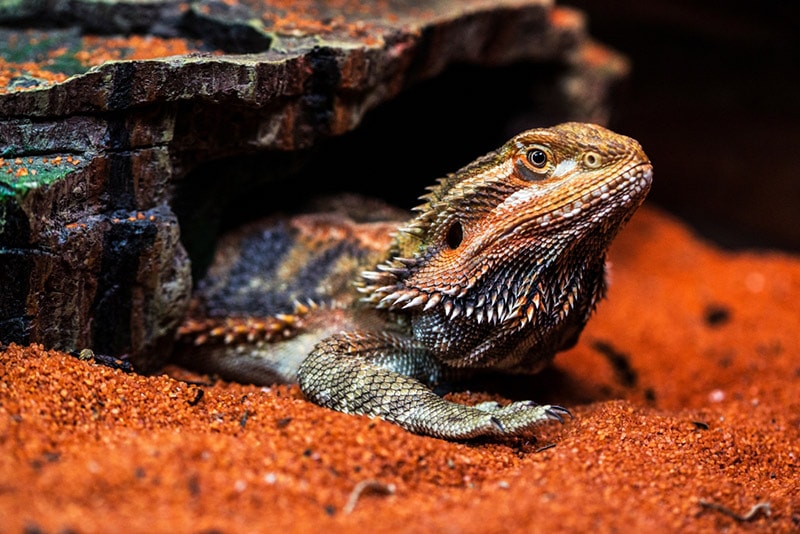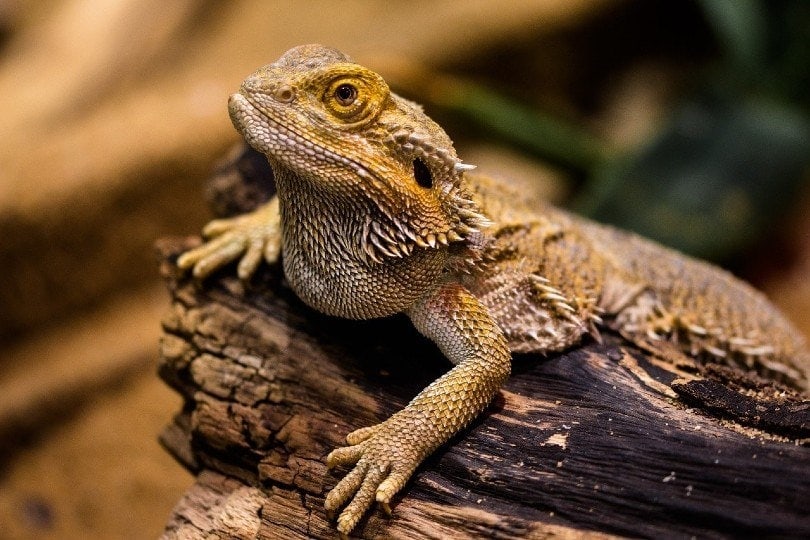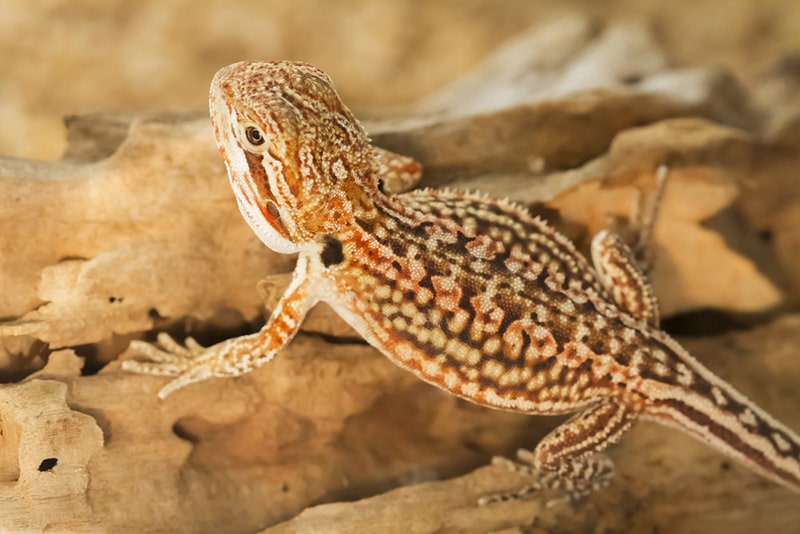How Much Is a Bearded Dragon? 2024 Cost Guide
Updated on

Click to Skip Ahead
Bearded dragons make wonderful pets, and they are often considered to be one of the top “starter” reptiles for new reptile keepers. They do have specific and unique needs, though. Anyone hoping to bring home a bearded dragon should understand the care needs of these reptiles, as well as the potential costs.
They may not be as costly as some reptiles, but there may be hefty up-front costs associated with the ownership of a beardie. There are also recurring costs throughout the life of these scaly pets that should be considered when deciding if a bearded dragon is the right pet for you. In general, you can expect to pay less than $500 for a bearded dragon with monthly costs of around $50–$100.
Bringing Home a New Bearded Dragon: One-Time Costs
The first time you bring a bearded dragon home, you’ll need to be well-versed in the proper care of these reptiles. You’ll need to be prepared with a proper enclosure, UV light, hygrometer, thermometer, proper substrate, appropriate food, and more.

Free
Although the average bearded dragon isn’t going to be dropped on your doorstep for free, many people acquire bearded dragons through friends and acquaintances who are no longer able to properly care for their bearded dragon. If someone needs to get rid of their bearded dragon, you may luck into all of the startup supplies being included for free.
Adoption
- $50–$100
Because of their complex care needs, it’s not uncommon for bearded dragons to end up in reptile rescues. These organizations often require full vetting of potential owners before approving them to adopt a bearded dragon. If you are approved, you can expect to spend anywhere from $50 to $100 on the adoption fees associated with your pet. This doesn’t include the costs associated with equipment.

Breeder
- $50–$500
You may be able to find a bearded dragon directly through a breeder, but you are more likely to find a bearded dragon from a breeder through a pet store. Depending on the color morph, you can expect to spend as little as $50 for a wild coloration bearded dragon, while specialty morphs can exceed $400–$500. Specialty morphs often must be purchased directly from a breeder and may be difficult to acquire through a pet store.
Initial Setup and Supplies
- $100–$1,000+
The initial setup costs associated with bringing home a bearded dragon can get expensive. The good news is that juvenile beardies need less space than full-grown adults, so you can get away with a smaller tank for a period of time with a juvenile.
When it comes to costs associated with a bearded dragon, you need to budget for an enclosure, substrate, food, a heat source, a UV source, a thermometer, a hygrometer, and more.

List of Bearded Dragon Care Supplies & Costs
| Enclosure | $50–$200+ |
| Heat Source | $20–$100 |
| UV Light | $20–$100 |
| Hygrometer | $10–$150 |
| Thermometer | $10–$150 |
| Substrate | $15–$60 |
| Supplements | $3–$20 |
| Food and Water Bowls | $3–$15 |
| Tank Décor | $20–$100+ |
| Food | $8–$25 |
| Cleaning Supplies | $5–$20 |
| Toys and Enrichment Items | $0–$50 |
How Much Does a Bearded Dragon Cost Per Month?
- $50–$100 per month
There are a handful of costs you can expect to recur every month. From food to tank maintenance to the cost of electricity, you can expect at least $50 to go to your beardie every month. Since some of this will be built into your utility bills, you may not even notice it, but you can still expect to spend around $20 or more monthly on food and supplies alone.

Health Care
- $0–$100 per month
The average bearded dragon won’t require monthly health care, so you’ll likely have multiple months where you have no health care expenses for them. If they do need medication or a vet visit, though, you can expect to spend between $50 and $75 on visit fees, plus additional costs for medications and other healthcare supplies.
Food
- $8–$25 per month
Food is one of the most basic expenses you should keep in mind when considering bringing home a bearded dragon. For juveniles, you’ll need to keep a steady stock of live insects on hand, while adults need more fruits and veggies. For beardies of any age, you’ll need access to live insects and fresh plant matter to support their nutritional needs.

Medications and Vet Visits
- $0–$100 per month
As previously mentioned, vet visits are likely to be few and far between with your average bearded dragon, so monthly vet visits or medication expenses are unlikely. It’s a good idea to at least set a little bit of money aside every month to get a health care fund going, though. If your beardie becomes ill and requires significant diagnostics and medical treatments, having a fund set aside can make a big difference for you.
Pet Insurance
- $0–$25 per month
Most people don’t get pet insurance for their reptiles, and if you’re interested in getting it, you may struggle to find coverage. Most pet insurance companies don’t cover bearded dragons and other exotic pets with their insurance policies. If having pet insurance coverage is important to you, be prepared to only have a few options to choose from. Coverage should be relatively affordable every month, likely costing $25 or less.

Environment Maintenance
- $0–$50 per month
Keeping your bearded dragon’s enclosure clean and hygienic is one of the top ways to keep them healthy. Reptile-safe cleaning supplies are needed to thoroughly clean the enclosure monthly, including all décor. UV bulbs need routine replacement, and although this won’t be a monthly expense, you should be prepared for it when the light you have begins to lose efficacy. The substrate should be fully replaced at least once per month if you are using disposable substrates, like bark or sand.
| Cleaning Supplies | $10/month |
| UV Light Replacement Bulbs | $20/month |
| Substrate | $20/month |
Entertainment
- $0–$40+ per month
While it’s often overlooked, bearded dragons can significantly benefit from enrichment items in their enclosure, including toys and interesting tank décor. Rotating through a selection of items can keep things fun and interesting for your beardie. Many enrichment items can be made through DIY projects with items you already have at home, so you may be able to get away with no spending in some months.

Total Monthly Cost of Owning a Bearded Dragon
- $50–$100 per month
At a minimum, you can expect to spend money on food and utilities for keeping all aspects of the enclosure running properly. Vet visits, medications, pet insurance, toys and enrichment items, and cleaning supplies may not be expenses that pop up every month, but you should aim to set aside a little bit of money every month. This will allow you to have a backup fund in case unexpected expenses pop up.
Additional Costs to Factor In
When you go out of town, you’ll likely need to pay an experienced pet sitter to care for your bearded dragon. It may take some research to find someone who is experienced enough to provide excellent care for your bearded dragon while you’re gone.
Owning a Bearded Dragon on a Budget
Owning a bearded dragon can be done on a budget, although the initial costs can be hefty if you’re on a tight budget. Make sure to properly identify the difference between budgeting and cutting corners. Food, cleaning supplies, utilities, and supplies like replacement UV bulbs are essential items that should not be skipped out on.

Saving Money on Bearded Dragon Care
One of the easiest ways to save money on your bearded dragon’s care is to acquire used items when possible. Used tanks, flooring tiles, heat lamps, UV lights, and even tank décor are all items that can be properly sterilized or reused safely. It’s not uncommon to find people who are giving away or selling used items, especially if you get connected with groups of reptile keepers in your area.
Conclusion
Bearded dragons are excellent pets if you’re looking for a reptile that will tolerate, and even enjoy, being handled. They aren’t the most budget-friendly pet available, though.
Proper husbandry is absolutely necessary to maintaining the health of a bearded dragon, as well as ensuring they live a long life. A commitment to proper husbandry should be the top priority for these animals. While there are ways to save money on care, it’s extremely important that you don’t find yourself cutting corners with proper care.
Featured Image Credit: Regina Robert, Shutterstock










